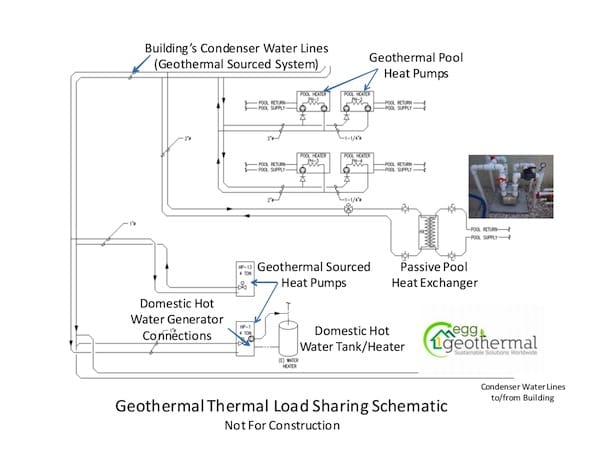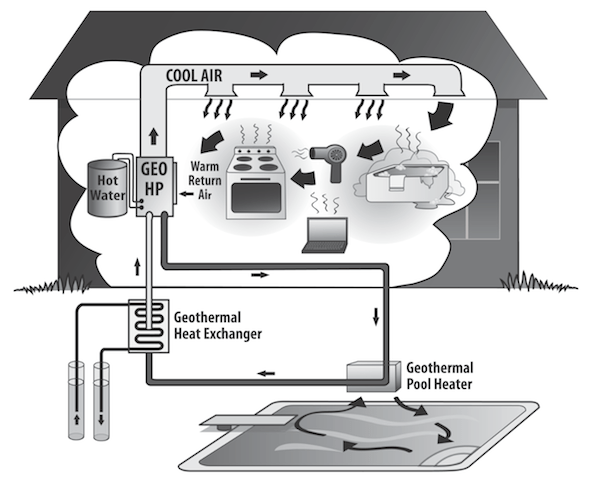Have you ever considered all of the computers, lighting, appliances and people that create heat and are a potential source of energy that can provide domestic hot water and be used to heat spas and pools? With standard air source heat pumps, cooling equipment, or cooling towers, all of the heat generated inside homes and commercial buildings typically goes up though the return air ductwork and is ultimately exhausted through outside air exchange.
Like geothermal sourced HVAC systems, geothermal pool heat pumps bring a swimming pool and potable water heating in harmony with nature, while providing high energy efficiency. They do that by working together with the stable earth temperatures to provide heating for the pool throughout your customer’s desired swimming season.
This can be a selling/buying point for a geothermal HVAC system. With some minor modifications, the waste heat from appliances and devices in the home can be channeled into usable heat for domestic hot water needs, swimming pools, and spas.
 Let’s look at the different ways that a pool is normally heated; Fossil fuel, electric resistance, solar, or heat pump (either “air sourced” or “geothermal sourced”).
Let’s look at the different ways that a pool is normally heated; Fossil fuel, electric resistance, solar, or heat pump (either “air sourced” or “geothermal sourced”).
Fossil fuel heating of potable water, pools and spas is an old favorite. First cost is relatively low, but that comes at a higher price environmentally and monetarily as you move forward.
The most energy efficient and renewable source for potable water and pool heating is solar-thermal, but solar is dependent upon the cooperation of the weather. Cloudy and cool days can mean a cold pool, and may require need for backup heating sources much of the year.
Electric resistance heating uses straight electricity through electrodes or heating elements over which the water passes, providing a clean and safe water heating alternative, but it can be pretty expensive, energy-wise. Using the Coefficient of Performance (COP) rating system for heating equipment, electric heating has a COP of 1.0, meaning that 1 unit of heat is provided for each unit of electricity, a one-to-one ratio, or 100% efficient in the COP rating system.
Air source heat pumps designed for pool and potable water heating use outside air, pumping heat out of the ambient air into your pool or hot water tank. However, they too rely somewhat on cooperative weather conditions, that is; air temperatures being warm enough to facilitate efficient extraction of heat to transfer to potable water and/or pool heating needs. Air source heat pump efficiencies are in the 3.0 COP ranges (300% efficient).
For swimming pool and spa heating, the best scenario is attained with a geothermal sourced water to water heat pumps, pulling heat from a dependable, steady and renewable energy source; the earth. Geothermal heat pumps can be about 5.0 COP (500% efficient).
By now, most of us know that geothermal heating and cooling, or low temperature geothermal applications involves tapping into the earth as a heat source for heat sink. Four to 6 feet below the ground, the temperature remains relatively constant year round (about 50F to 75F in the US). A geothermal sourced water to water heat pump, which can work in tandem with your customer’s geothermal HVAC system, typically consists of water sourced heat pump and a buried system of pipes called an earth loop, and/or a pump to reinjection (Class V thermal exchange process) well (More on this in previous Mechanical Hub Geothermal columns) This geothermal source can be shared between the building’s HVAC and water heating systems.
While your customer is paying for electricity to power their HVAC cooling system, they are also providing for the energy to run computers, lighting, blow dryers, ovens, and domestic water heating. Then the home’s HVAC system must use power to remove the heat created by all of these internal gains on top of the occupant loads (one occupant presents a load of 1200 BTU’s each hour). They pay for energy twice to remove this waste heat through the process of cooling their house. Why not channel that heat somewhere else where it’s needed? There is a way, and it’s easy with a geothermal sourced home –
Among the benefits that you can give your customer from a geothermal HVAC system is the ability to channel and use this waste heat energy. That’s because unlike the widely used air sourced cooling equipment (those that have an outside condenser that discharge waste heat), geothermal systems discharge the heat through a liquid heat exchanger. The heat is entrained in the discharge water line. Most manufacturers of geothermal heat pumps even have a factory installed hot water generator available. This option gives you two extra connections labeled DHW (Domestic Hot Water) “In” and “Out” that may be connected to most any hot water tank, and the geothermal heat pump can turn waste heat into usable hot water.
 There are thousands of geothermal heated pools around in the US. There is a good chance that the local YMCA, hotel, health club or community pool near you already has geothermal sourced pool heating. Surprisingly, many of these still have air sourced cooling systems that could be converted to geothermal (and likely will be) during the normal course of HVAC equipment attrition and upgrade (another opportunity for income for plumbing and heating contractors!).
There are thousands of geothermal heated pools around in the US. There is a good chance that the local YMCA, hotel, health club or community pool near you already has geothermal sourced pool heating. Surprisingly, many of these still have air sourced cooling systems that could be converted to geothermal (and likely will be) during the normal course of HVAC equipment attrition and upgrade (another opportunity for income for plumbing and heating contractors!).
Why not show you customers how they can stop paying two and three times to move energy, and share the loads in their homes and businesses; show them how you can help them to enjoy the savings of thermal load sharing with a geothermal HVAC system.
Does this make sense to you? Leave a comment and let me know what you think…
Jay Egg is a geothermal consultant, writer, and the owner of EggGeothermal. He has co-authored two textbooks on geothermal HVAC systems published by McGraw-Hill Professional. He can be reached at jayegg.geo@gmail.com.




Join the conversation: